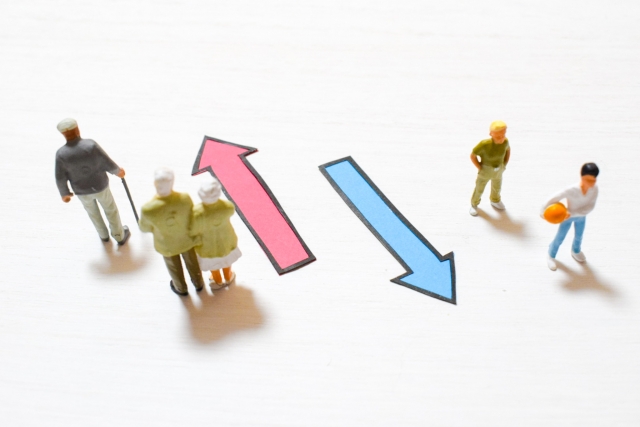◼ The declining birthrate has been a hot topic for over 30 years
The declining birthrate has been a social issue since the 1990s, when the bubble economy collapsed. The biggest news story recorded was the “1.57 shock” that made headlines in 1990. It was reported that the total fertility rate in fiscal 1989 had fallen to 1.57, below the Hinoeuma rate. (“Hinoeuma” refers to the event that occurred in 1968 when the birth rate dropped dramatically. )
In 1992, the issue of declining birthrates was addressed in the National Lifestyle White Paper. As the white paper at the time explained: ◇◇
Japan’s birth rate has been on a downward trend since 1983. Even recently, Japan’s birth rate has continued to decline, and according to the Ministry of Health, Labor and Welfare’s 1991 Vital Statistics, it has reached an all-time low of 1.53. …The shrinking population size accompanying the declining birthrate, along with a decrease in the working-age population, is expected to affect various aspects of people’s lives through the rapid increase in the proportion of the elderly population in the population structure. *Quoted from the Economic Planning Agency’s “FY1992 White Paper on National Life.” Some omissions are the author’s. ◇◇
More than 30 years ago, the government was already aware that the declining birthrate was a major issue. However, the reality is that no measures have been taken to stop the decline in the birth rate. The situation described in the White Paper seems to still apply to Japan today. Japan’s birth rate continues to fall contrary to predictions
Looking at the data, we can see that the birth rate has fallen faster than expected. For example, in 1985, the total fertility rate was expected to slowly recover from 1.75 to 2.0 in the future. However, the actual birth rate will continue to be lower than expected and will never return to 1.75 to 2.0. Contrary to predictions, the birth rate continued to decline. It is not that the government has not taken any steps during this time. In December 1994, the government formulated the Angel Plan. The Angel Plan is said to be the first comprehensive plan in Japan to combat the declining birthrate. The aim was to improve the employment and childcare environment so that people can balance work and childcare, such as by increasing the number of daycare centers and introducing extended childcare hours. According to the White Paper on Measures to Address the Declining Birthrate (2022 edition), since the implementation of the Angel Plan, more than 40 laws and plans have been put in place and formulated. In addition to reviewing policies that had been implemented in the past, we have expanded our measures to include work style reform for men and women, and support for marriage and childbirth. Despite this, the decline in the birth rate has not been halted. Why did the birth rate fall faster than predicted? The reason for the lower birth rate than predicted is that childbirth, child-rearing, and family life have changed more than expected. When predicting future birth rates, it is necessary to consider what actions people in the future will take regarding childbirth, child-rearing, and the ideal family. If people’s behavior and social customs change in the future, there is a high risk that birth rates will deviate significantly from expectations. For example, compared to what was envisioned in 1985, the image of the family in Japanese society today has changed considerably. According to the White Paper on Gender Equality (2022 edition), between 1980 and 2020,
the number of single-person households increased significantly, from 7.11 million to 21.15 million
and the number of single-parent households with children increased significantly, from 2.05 million to 5 million. On the other hand, the number of households consisting of a married couple and children decreased from 15.08 million to 13.95 million. The number of couples and children households, which were once considered a model case, is decreasing. Instead, single-parent households and single-person households have become more prominent. Changes in the working environment, including the advancement of women into the workforce, have progressed considerably since 1985. This is probably a sign that Japanese society is undergoing major changes in many areas, including decision-making regarding marriage, childbirth, and child-rearing, work styles, and values. The full article is below. [Maidona News] 2024/7/27 (Sat) 21:00.

The Ministry of Health, Labour and Welfare has been considering this a problem since the 1980s
They completely ignored it, and it wasn’t until the 1990s that they finally took it up as a government issue, but they didn’t do anything about it, and they only started talking about it in the 2010s when it was too late – that’s Japan’s third-rate politics.
|д゚) A glimpse.
This is it.
They abandoned the Ice Age generation, which made up the majority of the population.
Rather, isn’t it the Liberal Democratic Party, which has been steadily leading Japan down a path of decline, that is competent?
I don’t want to have children to be slaves to support the aristocracy.
The LDP Kurdish Friendship League: “If we invite 40 million Kurds from all over the Middle East, we can solve the problem of low birth rates and labor shortages within a year.”
Are Japanese people really stupid for choosing such a government?
It’s irrelevant.
Real wages are rising in Europe, the US, and China and Korea, but the birthrate is also declining.
and this is what has led to the current declining birthrate. The only ally the family has is the Unification Church.
Families have become divided and weak due to the trend towards nuclear families, and the wealthy are united through a society of connections.
Before denying connections, it would be better to not hate village society too much and restore the power of local communities and the like.
Komatsu Sakyo and Okamoto Taro also agreed.
Since then, the birth rate has steadily fallen, and we are in this situation.
Kishi Nobusuke tried to embody the idea of the founder of the Tsubo religion that Japan has too many people and that half the population would be fine.
I don’t know if immigration will do the trick, but I think it will destroy Japan so much that immigrants won’t even come.
In general, the birthrate will be low all over the world, so there will be a fight over labor.
It goes without saying that there is no money, but not only childcare costs but also housing costs are a blind spot.
When it comes to motivation, the only thing people talk about is the difficulties, so no one wants to have and raise children anymore.
The birthrate is declining because it’s impossible to raise more than two children in a nuclear family with both partners working.
In fact, a decline in the birth rate has been predicted for 30 years.



Comments